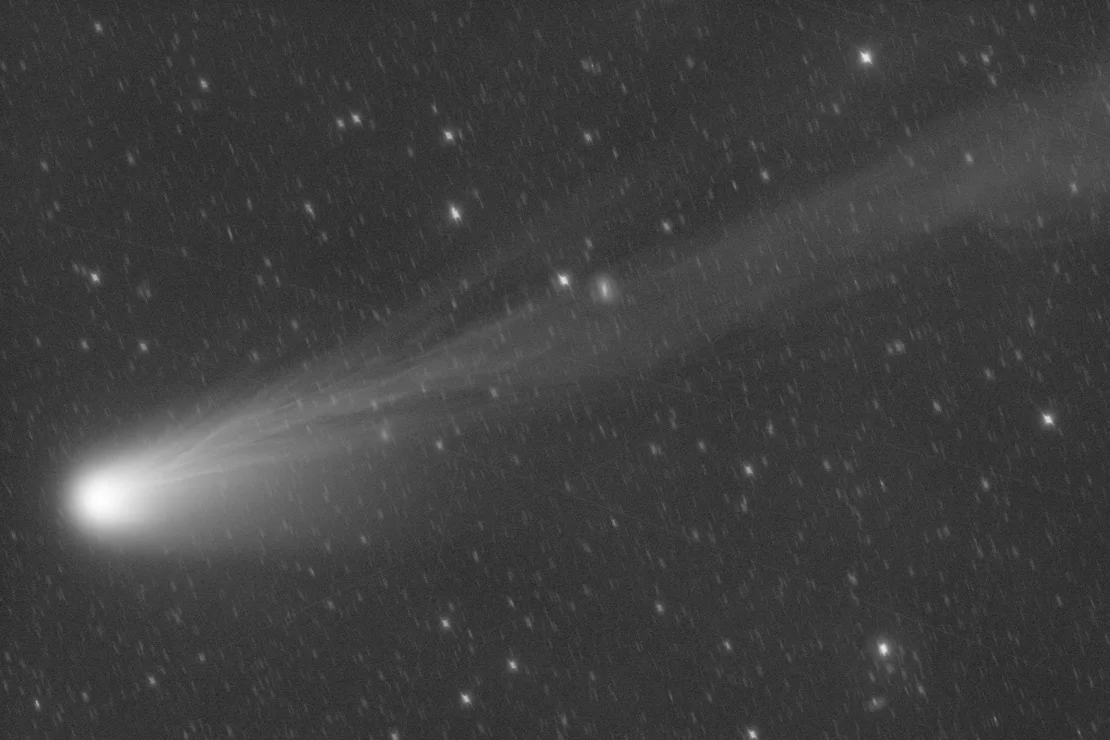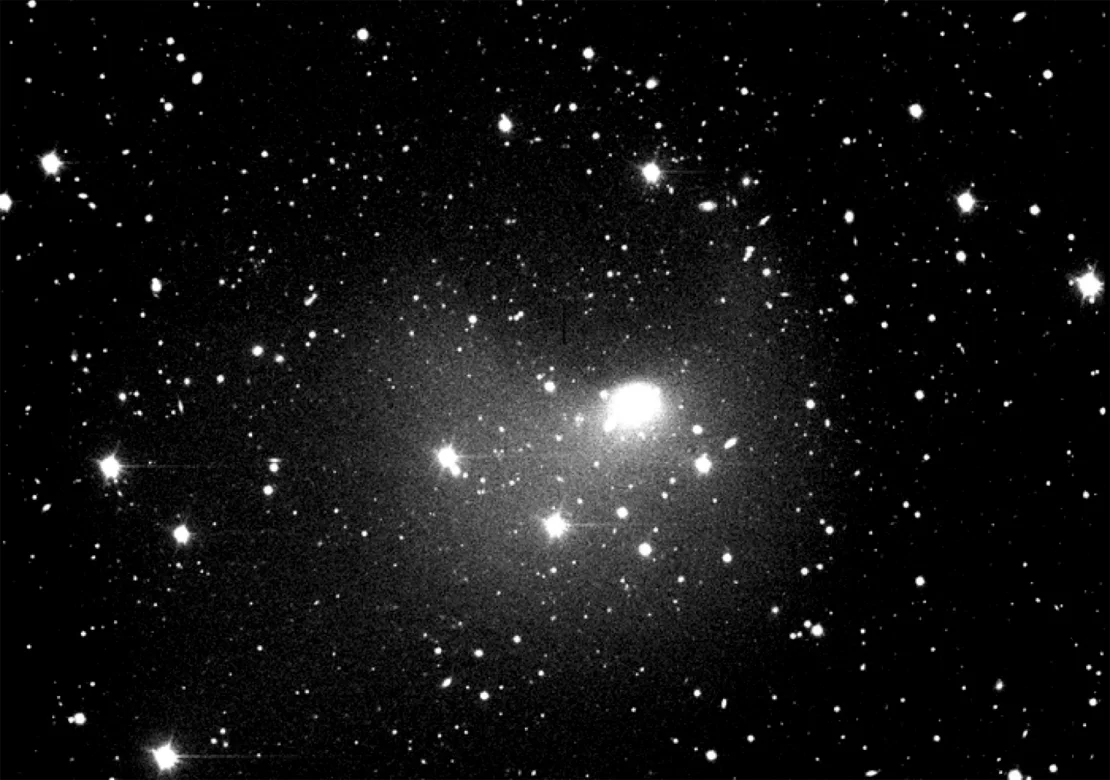(CNN) — An unusual horned comet, notable for its series of explosions and nicknamed the “Devil's Comet,” will make its closest approach to Earth this Sunday around 3 a.m. ET.
Although the comet has not been visible to those in the Northern Hemisphere since the first week of May, sky watchers in the Southern Hemisphere have a better chance of seeing the obscure object through binoculars or binoculars.
Why the dynamic comet takes on a shape that resembles the Millennium Falcon spacecraft from the “Star Wars” movies when it's explosively active remains a mystery to scientists. But like Halley's Comet, the celestial object completes an orbit around the Sun only once every 71 years, making it a once-in-a-lifetime opportunity to observe it closely.
Since the comet will not pass Earth for decades, collective observations by astronomers can provide important information about its true nature and behavior.
Officially known as Comet 12P/Pons-Brooks, the object made its closest approach to the Sun on April 21, coming within 119.7 million kilometers (74.4 million miles) of our star.
The comet will pass very close to Earth on Sunday, but it will be 230 million kilometers from our planet and will not represent a danger. For reference, the Sun is 149 million kilometers (93 million miles) from Earth.

A virtual telescope project captured a view of the comet over Manciano in the Italian region of Tuscany under dark skies over the peninsula. Gianluca Masi/Virtual Telescope Project
The comet's brightness peaked in late April and has been steadily fading for three to four weeks, said Dr. Dave Schleicher, an astronomer at Lowell Observatory in Arizona.
“For people below the equator, the weeks and months after the 1950s will be the first good chance to see it,” said astronomer Dr. Teddy Carretta, a postdoctoral fellow at Lowell.
Two great discoverers, Jean-Louis Pons and William Robert Brooks, independently observed Comet Diablo: Pons in 1812 and Brooks in 1883. But before the comet thought of comets as anything else, it may have made several trips around the Sun over thousands of years. “There was something strange in the atmosphere,” Schleicher said.
Astronomers estimate the large comet to be between 10 and 20 kilometers in diameter (6.2 and 12.4 miles), Carretta said.
The rare visitors have the green appearance common to most comets because they contain diatomic carbon molecules that absorb sunlight and emit a color that appears green from our perspective, Schleicher said.
A series of cosmic explosions
Ponce-Brooks recently caught the attention of astronomers after the comet exhibited puzzling behavior as it formed a horn and rose into our solar system.
The comet has undergone a series of explosions over the past eight months, spewing gas and dust. Such releases are not uncommon in comets, and while others have a crescent or Pac-Man shape, it's hard to say what's normal for Ponce-Brooks.
“I would say it's unusual because of the number of outbreaks he's had,” Schleicher said. “On the other hand, it's not like you have good records from the past that allow you to really know what's typical. And, given the large number of outbreaks in the last eight months, I doubt this is typical of Ponce-Brooks.”
Comets are dust, rock and ice, the frozen remnants of the formation of the Solar System. They also contain frozen elements like carbon dioxide and carbon monoxide.
Comets get hotter and brighter as they get closer to the Sun, and some of the frozen gas stored in comets doesn't need to heat up much before they start turning into vapor, Schleicher said.

The expanding bright spot (center) is an explosion from comet 12P/Pons-Brooks, captured in this October 2023 image by the Lowell Discovery Telescope in Arizona.
“Certainly, we think that warming from the sun is the determining factor,” he said. “The comet approaches; It has been frozen for years. “Heat moves from the surface to where the carbon dioxide or carbon monoxide ice is.”
Astronomers suspect that Ponce-Brooks explosions occur during repeated events as heat vaporizes material inside the comet, causing pressure to build up and rupture the surface. Although a gas explosion would not be visible through telescopes, the dust it kicks up would produce the type of phenomena observed from Ponce-Brooks, Schleicher said.
Scientists have detected jets of material released from the comet during the comet's explosion to two source regions on its surface. Astronomers wonder “why the whole surface doesn't explode like crazy,” Schleicher said.
The observations indicate that ice has formed on much of the surface or that the ice has evaporated, leaving behind only dirt, but astronomers “are not sure which of those mechanisms is controlling the event,” he said.
However, the comet's explosions appear to have stopped, and it hasn't shown any activity since February, Carretta said.
What we can learn from comets
Astronomers are looking at Ponce-Brooks in hopes of discovering more details about its rotation speed, or the speed at which comets spin as they move through space. Ponce-Brooks has a rotation period of 57 hours, longer than expected, and astronomers want to know whether the jet of material emitted by the comet is speeding it up or slowing it down.
A series of overlapping events may have contributed to Ponce-Brooks' unique appearance, but it may also be due to our view of the comet, Carretta said.
“These are three-dimensional objects,” Garetta said. “When we take pictures of the night sky, we take them in limited colors, everything is flat in two dimensions. “It makes a lot of sense to you, if you can walk around and look at them from two different perspectives, they look more complicated than they really are.”




:format(jpeg):focal(637x503:647x493)/cloudfront-us-east-1.images.arcpublishing.com/gfrmedia/NC62R4ZIHJGPBJARHLZIOHFT64.jpeg)